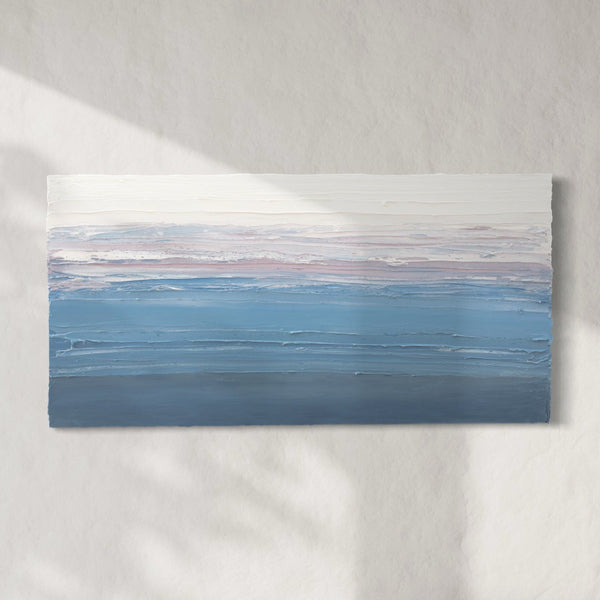So, you've purchased artwork. Now what? Whether it's a $200 print or a $5000 original oil painting, it's important to care for your artwork so that remains in excellent condition for years to come - not only because artwork is an investment, but because you acquired it to enhance your space and make you happy. And that won't happen if it's damaged, right? Fear not! To help you keep your art in tip-top shape, we'll run down five simple tips on how to care for your artwork.
1. Hang artwork outside of direct sunlight.
Even though we love the sun (gearing up for that summer glow right now TBH), art does not thrive in it the way we do. Exposure to direct sunlight over time can lead to the pigment fading or exposed canvas becoming damaged. However, it's important to know that acrylic paintings are typically the most resilient to light exposure, while watercolor paintings and photography on paper are the most susceptible to noticeable fading. But a good rule of thumb: When in doubt, leave it out (of the sun).
2. Keep it clean.
There's no need to add "clean the art" to your weekly list of chores. But taking a quick look at your original paintings or pieces under plexiglas and glass every 4-6 months is a good idea. If you notice dust build-up on the surface of an oil or acrylic painting, for example, it's time to give it a little dust to avoid drying out the paint. For this, you'll just want a soft, natural-hair bristle brush. Brush it lightly over the surface of the painting to remove the dust and debris. Steer clear of dusting with cloths, as they won't be as effective but also can snag over the surface, especially on impasto paintings with heavier texture.

Encaustic paintings, on the other hand, may be buffed using a cotton t-shirt (plain t-shirt area only - no printed portions) to enhance the surface of the piece. Do not use any type of cleaning spray, water, or agent to clean your paintings.
If the artwork is framed with museum glass or plexiglas, gently clean it with ammonia-free cleaner on a lint-free cloth, as needed.
3. Keep art a safe distance from water sources, like sinks and showers.
Similar to sunlight, water is not the best companion for your artwork. For gallery wrapped canvas, repeated steam exposure can warp the stretcher bars, so that the painting does not rest flat on the wall. In extreme cases, paintings, drawings, photography, or prints which are under plexiglass or glass may end up with condensation inside the glass, which is sure to damage the artwork itself. Therefore, it's best to keep high-value pieces out of the kitchen, and especially full bathrooms with showers. Opt instead to place artwork made with more durable materials in the bathroom - like metal, glass, or mirror - but always be sure to check with the gallery or artist about special care instructions first. So again... when it doubt, leave it out (of the bathroom).
4. Pay attention to temperature and humidity.
This tip piggybacks off of Tips 1 and 3, and so if you're cognizant of sunlight and water, you'll likely stay safe when it comes to temperature and humidity. Avoid extremes in all cases and keep both at an average, like standard room temperature and 40% - 60% relative humidity. Encaustic paintings, for example, are made with wax, and wax can melt at approximately 150 degrees Fahrenheit - so encaustic artwork should never be left in a car during transit. Avoid swings in either temperature or humidity, and your art should stay happy.

5. Store with care.
We prefer artwork to be out and and on display everyday, all the time. But we know that sometimes it needs to be stored - maybe because you're moving, or maybe it's just because you have such a vast collection, you have to curate your space by rotating it out (sounds good to us). So first and foremonst, in the event that you do have to store your artwork, keep Tip 4 regarding temperature and humidity top-of-mind.
Next, stack your paintings flat against one another, against a flat, stable surface - preferably a wall. And remember to have stretcher bars rest over stretcher bars, so that the corner of one painting (or any other sharp object) is not pushing into the canvas of another. This can lead to dents in the canvas. Avoid stacking the back of a painting against the front of another, too, as the wiring and d-rings on the back of a frame or gallery wrapped canvas may scratch the face of the painting behind it. Instead, stack painting faces toward one another (you can put a piece of cardboard between the two to keep them clean), and stack painting backs toward one another.
Finally, it's ideal to rest artwork on crates or something stable to prevent them from having direct contact with the ground, in case of flooding, for example. You can even purchase foam corners to give your stored art a little extra protection.
Want to learn more about protecting your artwork from experts all over the country, including Sorelle's own Founder, Sandy Pelletier? Check out Art Protection: What Experts Have to Say on Porch.com for more!
If you're eying artwork from the Sorelle collection and aren't sure about placement or storage best practices for that specific medium, contact us! Our Art Advisors can help you determine the best artwork for your space. Learn more about our complimentary Art Advisory services here, or start expanding your art collection by browsing by Artist.




2 comments
Post a comment
Ava M
It did catch my attention when you said that your canvas can end up getting damaged and cause it to fade when it is exposed to direct sunlight. This must be shared with my parents because they need to have two of their paintings restored after getting damaged due to a hurricane last month. I will ask them to follow your tips to ensure that their paintings are going to be properly cared for moving forward. https://www.theartofframing.com.au/custom-picture-framing/
Shammy Peterson
Thanks for pointing out the need to avoid swings in either temperature or humidity to keep your artwork safe and damage-free. This is something that I will share with my father because he is planning to move three of his paintings to a storage facility before renovating his house next month. I will ask him to take note of your tips to keep his artwork collections damage-free for a long time. https://www.lafineart.com/